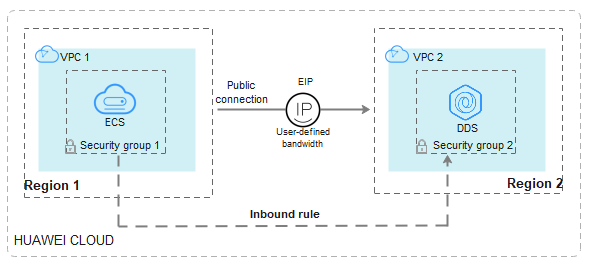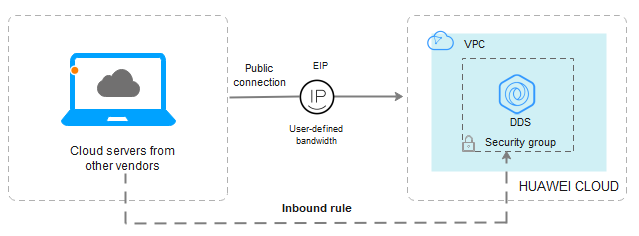Connecting to a Cluster Instance Using Mongo Shell (Public Network)
Scenarios
In the following scenarios, you can access a DDS instance from the Internet by binding an EIP to the instance.
Scenario 1: Your applications are running on an ECS that is in a different region from the one where the DDS instance is located.

Scenario 2: Your applications are deployed on a cloud server provided by other vendors.

This section describes how to use Mongo Shell to connect to a cluster instance over a public network.
You can connect to a cluster instance using an SSL connection or an unencrypted connection. The SSL connection is encrypted and more secure. To improve data transmission security, connect to instances using SSL.
Prerequisites
- For details about how to create and log in to an ECS, see Purchasing an ECS and Logging In to an ECS.
- Bind an EIP to the cluster instance and set security group rules to ensure that the instance can be accessed from the ECS.
- You have installed the MongoDB client on the ECS.
For details about how to install a MongoDB client, see How Can I Install a MongoDB Client?
SSL Connection

If you connect to an instance over the SSL connection, enable SSL first. Otherwise, an error is reported. For details about how to enable SSL, see Enabling and Disabling SSL.
- Log in to the management console.
- Click
 in the upper left corner and select a region and a project.
in the upper left corner and select a region and a project. - Click
 in the upper left corner of the page and choose Databases > Document Database Service.
in the upper left corner of the page and choose Databases > Document Database Service. - On the Instances page, click the instance name.
- In the navigation pane on the left, choose Connections.
- In the Basic Information area, click
 next to the SSL field.
next to the SSL field. - Upload the root certificate obtained in 6 to the ECS.
The following describes how to upload the certificate to a Linux and Windows ECS:
- In Linux, run the following command:
scp<IDENTITY_FILE><REMOTE_USER>@<REMOTE_ADDRESS>:<REMOTE_DIR>

- IDENTITY_FILE is the directory where the root certificate resides. The file access permission is 600.
- REMOTE_USER is the ECS OS user.
- REMOTE_ADDRESS is the ECS address.
- REMOTE_DIR is the directory of the ECS to which the root certificate is uploaded.
- In Windows, upload the root certificate using a remote connection tool.
- In Linux, run the following command:
- Connect to the instance in the directory where the MongoDB client is located.
Method 1: Using a public network connection address
Example command:
./mongo <Public network connection address> --ssl --sslCAFile <FILE_PATH> --sslAllowInvalidHostnames
Parameter description:
- Public Network Connection Address: On the Instances page, click the instance to switch to the Basic Information page. In the navigation pane on the left, choose Connections. On the displayed page, click the Public Connection tab. In the Address area, obtain the instance connection address from the Public Network Connection Address field.
Figure 3 Obtaining the public network connection address

The format of the public connection address is as follows. The database username rwuser and authentication database admin cannot be changed.
mongodb://rwuser:<password>@192.168.xx.xx:8635/test?authSource=admin
Pay attention to the following parameters in the public connection address:
Table 1 Parameter description Parameter
Description
rwuser
Account name, that is, the database username.
<password>
Password for the database account. Replace it with the actual password.
If the password contains at signs (@), exclamation marks (!), dollar signs ($), percent signs (%), or plus signs (+), replace them with hexadecimal URL codes (ASCII) %40, %21, %24, %25, and %2B respectively.
For example, if the password is ****@%***!$+, the corresponding URL code is ****%40%25***%21%24%2B.
192.168.xx.xx:8635
EIP and port bound to the dds mongos node of the cluster instance
test
The name of the test database. You can set this parameter based on your service requirements.
authSource=admin
The authentication database of user rwuser must be admin. authSource=admin is fixed in the command.
- FILE_PATH is the path for storing the root certificate.
- --sslAllowInvalidHostnames: To ensure that the internal communication of the cluster does not occupy resources such as the user IP address and bandwidth, the cluster certificate is generated using the internal management IP address. --sslAllowInvalidHostnames is needed for the SSL connection through a public network.
Command example:
./mongo mongodb://rwuser:<password>@192.168.xx.xx:8635/test?authSource=admin --ssl --sslCAFile /tmp/ca.crt --sslAllowInvalidHostnames
Method 2: Using an EIP
Example command:
./mongo --host <DB_HOST> --port <DB_PORT> -u <DB_USER> -p --authenticationDatabase admin --ssl --sslCAFile <FILE_PATH> --sslAllowInvalidHostnames
Parameter description:
- DB_HOST is the EIP bound to the instance to be connected.
You can click the instance name to go to the Basic Information page. In the navigation pane on the left, choose Connections. On the Public Connection tab, obtain the EIP bound to the dds mongos node in the EIP column.
If there are multiple dds mongos nodes, the EIP of any node can be used to connect to the instance.
Figure 4 Obtaining an EIP
- DB_PORT is the port of the instance to be connected. The default port number is 8635.
You can click the instance name to go to the Basic Information page. In the navigation pane on the left, choose Connections. On the displayed page, click the Public Connection tab and obtain the port from the Database Port field in the Basic Information area.
Figure 5 Obtaining the port
- DB_USER is the database user. The default value is rwuser.
- FILE_PATH is the path for storing the root certificate.
- --sslAllowInvalidHostnames: To ensure that the internal communication of the cluster does not occupy resources such as the user IP address and bandwidth, the cluster certificate is generated using the internal management IP address. --sslAllowInvalidHostnames is needed for the SSL connection through a public network.
Enter the database account password when prompted:
Enter password:
Command example:
./mongo --host 192.168.xx.xx --port 8635 -u rwuser -p --authenticationDatabase admin --ssl --sslCAFile /tmp/ca.crt --sslAllowInvalidHostnames
- Public Network Connection Address: On the Instances page, click the instance to switch to the Basic Information page. In the navigation pane on the left, choose Connections. On the displayed page, click the Public Connection tab. In the Address area, obtain the instance connection address from the Public Network Connection Address field.
- Check the connection result. If the following information is displayed, the connection is successful.
mongos>
Unencrypted Connection

If you connect to an instance over an unencrypted connection, disable SSL first. Otherwise, an error is reported. For details about how to disable SSL, see Enabling and Disabling SSL.
- Log in to the ECS.
- Connect to the instance in the directory where the MongoDB client is located.
Method 1: Using a public network connection address
Example command:
./mongo <Public network address>
Public Network Connection Address: You can click the instance name to go to the Basic Information page. In the navigation pane on the left, choose Connections. On the displayed page, click the Public Connection tab. In the Address area, obtain the instance connection address from the Public Network Connection Address field.
Figure 6 Obtaining the public network connection address
The format of the public connection address is as follows. The database username rwuser and authentication database admin cannot be changed.
mongodb://rwuser:<password>@192.168.xx.xx:8635/test?authSource=admin
The following table describes the required parameters in the public connection address.
Table 2 Parameter description Parameter
Description
rwuser
Account name, that is, the database username.
<password>
Password for the database account. Replace it with the actual password.
If the password contains at signs (@), exclamation marks (!), dollar signs ($), percent signs (%), or plus signs (+), replace them with hexadecimal URL codes (ASCII) %40, %21, %24, %25, and %2B respectively.
For example, if the password is ****@%***!$+, the corresponding URL code is ****%40%25***%21%24%2B.
192.168.xx.xx:8635
EIP and port bound to the dds mongos node of the cluster instance
test
The name of the test database. You can set this parameter based on your service requirements.
authSource=admin
The authentication database of user rwuser must be admin. authSource=admin is fixed in the command.
Command example:
./mongo mongodb://rwuser:<password>@192.168.xx.xx:8635/test?authSource=admin
Method 2: Using an EIP
Example command:
./mongo --host <DB_HOST> --port <DB_PORT> -u <DB_USER> -p --authenticationDatabase admin
Parameter description:
- DB_HOST is the EIP bound to the instance to be connected.
You can click the instance name to go to the Basic Information page. In the navigation pane on the left, choose Connections. On the Public Connection tab, obtain the EIP bound to the dds mongos node in the EIP column.
If there are multiple dds mongos nodes, the EIP of any node can be used to connect to the instance.
Figure 7 Obtaining an EIP
- DB_PORT is the port of the instance to be connected. The default port number is 8635.
You can click the instance name to go to the Basic Information page. In the navigation pane on the left, choose Connections. On the displayed page, click the Public Connection tab and obtain the port from the Database Port field in the Basic Information area.
Figure 8 Obtaining the port
- DB_USER is the database user. The default value is rwuser.
Enter the database account password when prompted:
Enter password:
Command example:
./mongo --host 192.168.xx.xx --port 8635 -u rwuser -p --authenticationDatabase admin
- DB_HOST is the EIP bound to the instance to be connected.
- Check the connection result. If the following information is displayed, the connection is successful.
mongos>
Feedback
Was this page helpful?
Provide feedbackThank you very much for your feedback. We will continue working to improve the documentation.See the reply and handling status in My Cloud VOC.
For any further questions, feel free to contact us through the chatbot.
Chatbot





